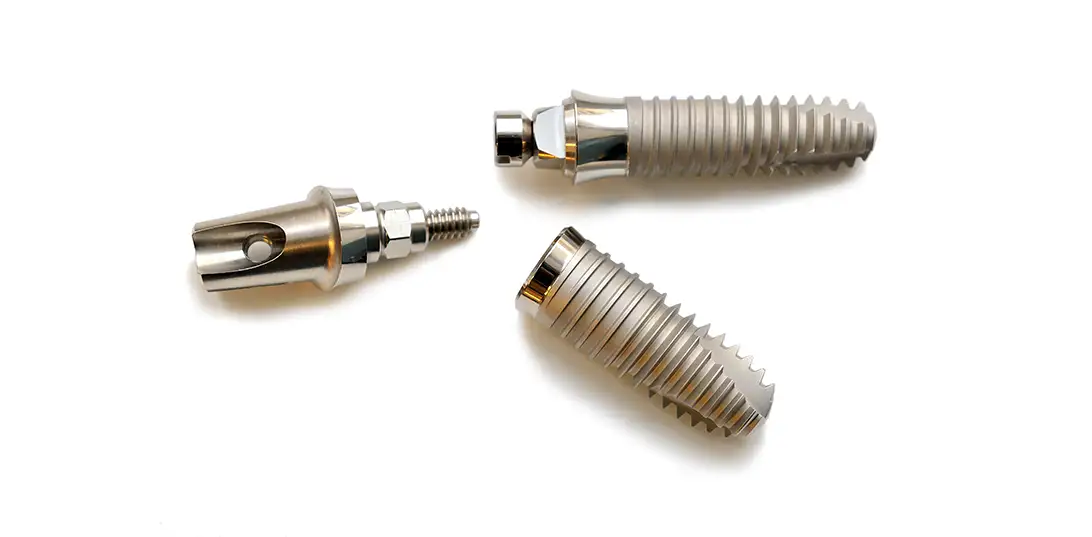What are dental implants?
Dental implants are the perfect aesthetic solution for all people who are missing one or more teeth in their jaw. The implant itself is a type of screw that is inserted directly into the jawbone and replaces the root of the missing tooth. They are made of biocompatible materials so they are safe for the human body. Their advantage is the replacement of one or more teeth without grinding adjacent teeth.
Also, it is very important for you to know that dental implants imitate the root of the tooth and contribute to the preservation of the natural appearance of the facial features as well as the smile. In patients without teeth (total toothlessness), implants serve as supports for fixed restorations (bridges) or for hanging prostheses.
Types of implants
There are two types of implants on the market: titanium and zirconium implants.
Today, dental implants are most often made of titanium, a metal that does not cause allergies or irritation. Titanium has a high degree of biocompatibility and an excellent predisposition for fusion with the bone itself (osteointegrative properties).
Zirconium is a new material, a modern variant that is new on the market.
Implant installation process
The implant installation process is painless with local anesthesia, takes no more than 15 minutes and consists of two parts: a titanium screw that is inserted into the jawbone and replaces the root of the missing tooth and the suprastructure (the connection between the implant and the crown), on which it is made crown. After the screw is embedded in the jawbone, wait 3 to 6 months for the bone to fuse with the implant (osteointegration) and then the dental crown is placed.
How long do dental implants last?
As for the durability of the dental implant, once the body accepts it, we can freely say that in most cases it lasts for life. Controls are recommended every six months, oral hygiene is mandatory, and dental implant crowns should be replaced every ten years.
Are you a candidate for implants?
Implant installation as well as prosthetic works are not performed on patients under 18 years of age because the bone growth has not yet formed. But that’s why there is no upper age limit for implant placement.
FAQ
Let’s answer your most frequently asked questions.
Dental implant installation is always done under local anesthesia, so the installation process is painless.
It happens that certain organisms react differently than usual to the installation of the implant, and if the implant is rejected, it usually occurs during the first year after the operation. Rejection of the implant occurs when it does not bond to the bone due to infection. That is why maintaining oral hygiene is very important. In the case of rejection of the implant, it is removed, leaving a wound that heals quickly.
Augmentation is an increase or extension of the jawbone and is needed by anyone in whom the dentist determines that the height of the tooth bone is not sufficient to place a dental implant in it. This usually happens when you lose a tooth for some reason, and over time, bone loss in that part of the jaw inevitably follows. The more time that passes between the extraction of the tooth and the installation of the implant, the greater the chances that you will need the installation of artificial bone.
It should take at least 4 to 6 months.
Dental implant installation is always done under local anesthesia, so the installation process is painless.
It happens that certain organisms react differently than usual to the installation of the implant, and if the implant is rejected, it usually occurs during the first year after the operation. Rejection of the implant occurs when it does not bond to the bone due to infection. That is why maintaining oral hygiene is very important. In the case of rejection of the implant, it is removed, leaving a wound that heals quickly.
Augmentation is an increase or extension of the jawbone and is needed by anyone in whom the dentist determines that the height of the tooth bone is not sufficient to place a dental implant in it. This usually happens when you lose a tooth for some reason, and over time, bone loss in that part of the jaw inevitably follows. The more time that passes between the extraction of the tooth and the installation of the implant, the greater the chances that you will need the installation of artificial bone.
It should take at least 4 to 6 months.
Don’t miss our promotions and advice..
Be the first to know.



